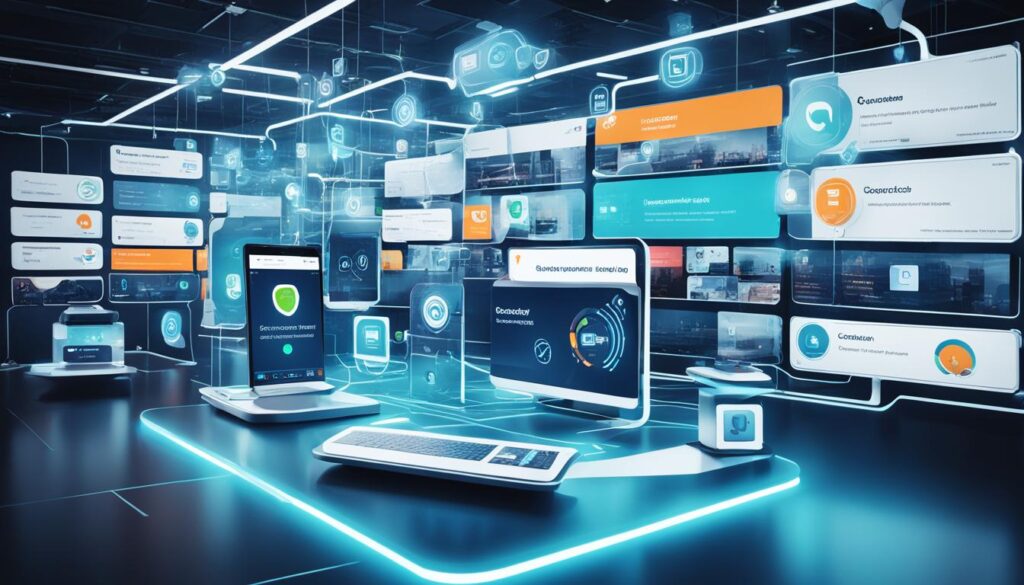Customer service is not just about resolving issues anymore. In 2023, it’s all about delivering exceptional experiences that foster long-term connections with customers. To achieve this, businesses need to stay ahead of the curve by embracing the latest customer service trends.
The customer service landscape is constantly evolving, driven by advancements in technology, changing consumer expectations, and the power of social media. In this digital transformation era, companies must adapt to meet customer needs across various channels and leverage artificial intelligence to streamline support processes.
One of the prominent trends shaping customer service in 2023 is the rise of omnichannel support. Customers expect seamless interactions and consistent experiences no matter which channel they choose to engage with a brand. Implementing omnichannel customer support ensures that businesses can meet these expectations and provide a unified experience.
Another trend that is gaining momentum is the integration of artificial intelligence in customer service, particularly through the use of chatbots. These intelligent virtual assistants can provide instant responses, personalized interactions, and even self-service options, improving customer satisfaction and reducing response times.
Social media has become a powerful platform for customer service. Brands need to be active on social media channels, responding to customer inquiries and feedback promptly. Engaging with customers on social media not only resolves issues publicly but also builds brand trust and loyalty.
Personalization is also an essential aspect of modern customer service. By leveraging customer data and preferences, businesses can create tailored experiences that resonate with individual customers. Personalized interactions and recommendations show customers that they are valued and understood, strengthening the bond between the customer and the brand.
Key Takeaways
- Customer service trends in 2023 focus on creating exceptional customer experiences.
- Omnichannel support ensures consistent interactions across multiple channels.
- Artificial intelligence, such as chatbots, improves response times and personalization.
- Social media is a powerful platform for customer service and brand engagement.
- Personalization enhances customer satisfaction and strengthens customer-brand relationships.
What is Customer Service?
Customer service is the backbone of any successful business, encompassing all interactions between a company and its customers. Its goal is to address customer needs, concerns, and inquiries promptly and effectively. Exceptional customer service fosters loyalty and advocacy, ultimately driving business growth.
At its core, customer service involves understanding and meeting the unique needs of each customer. Whether it’s resolving a technical issue, providing product recommendations, or addressing billing inquiries, exceptional customer service goes beyond transactional interactions. It involves building genuine relationships, demonstrating empathy, and finding solutions that exceed customer expectations.
When customers reach out to a company with their concerns or questions, they expect prompt and helpful assistance. Providing exceptional customer service means being readily available to address inquiries, whether through phone calls, emails, live chat, or social media platforms. By offering various communication channels, companies can cater to different customer preferences and ensure their needs are met efficiently.
Customer service also entails actively listening to customers and acknowledging their concerns. Whether it’s a complaint or a suggestion for improvement, every customer interaction is an opportunity to learn and grow. By valuing customer feedback, companies can make necessary adjustments to their products, services, and processes, ultimately enhancing the overall customer experience.
Exceptional customer service goes beyond resolving immediate issues; it focuses on building strong relationships with customers. By providing personalized and tailored experiences, companies can show their commitment to customer satisfaction. This could involve remembering customer preferences, anticipating their needs, and proactively reaching out with relevant offers and information.
Ultimately, exceptional customer service sets a company apart from its competitors. When customers feel valued, heard, and supported, they become loyal advocates for the brand. Positive interactions and experiences lead to long-term customer relationships, increased customer loyalty, and ultimately, business growth.
The Changing Landscape of Customer Service in 2023
The customer service landscape has undergone significant transformations in recent years. These changes have been driven by advancements in technology, evolving consumer expectations, the power of social media, access to data-driven insights, and a shift towards proactive support. To remain competitive and deliver exceptional customer experiences, companies must adapt and embrace these customer service developments.
Advancements in technology have revolutionized the way companies interact with their customers. From artificial intelligence-powered chatbots to personalized recommendations based on customer data, technology has enabled businesses to provide more efficient and tailored support. This gives companies a competitive advantage in meeting changing consumer expectations.
The power of social media cannot be overstated in the modern customer service landscape. Consumers now have the ability to voice their opinions, share experiences, and connect with brands on various social media platforms. This presents both challenges and opportunities for businesses to engage with customers and build meaningful relationships.
“The rise of social media has made customers more empowered than ever before.”
Access to data-driven insights has transformed the way companies understand their customers. By leveraging data analytics, businesses can gain actionable insights into customer preferences, behaviors, and pain points. This enables them to make informed decisions and provide proactive support that addresses customer needs before they even arise.
Proactive support has become a key differentiator in the customer service landscape. Businesses that can anticipate customer needs and provide timely assistance have a significant advantage in fostering customer loyalty and satisfaction. By leveraging data-driven insights and technology, companies can deliver personalized and proactive support that exceeds customer expectations.
To illustrate the changing landscape of customer service, consider a scenario where a customer reaches out to a company’s customer service department via social media. The customer’s message is promptly addressed by an AI-powered chatbot, which uses data-driven insights to provide personalized recommendations and resolve the customer’s issue effectively. This proactive support not only resolves the customer’s immediate concern but also creates a positive and memorable experience, ultimately fostering long-term customer loyalty.

In conclusion, the customer service landscape in 2023 is shaped by customer service developments, advancements in technology, changing consumer expectations, the power of social media, data-driven insights, and proactive support. Companies that embrace these changes and leverage them to deliver exceptional customer experiences will gain a competitive advantage and build long-lasting relationships with their customers.
Top Emerging Customer Service Trends in 2023
The customer service landscape is constantly evolving, driven by the latest developments and innovations. In 2023, several trends are shaping the future of customer service, revolutionizing the way businesses engage with their customers. By staying ahead of these trends, businesses can deliver exceptional experiences that foster long-term relationships. Let’s explore the top emerging customer service trends in 2023.
1. Artificial Intelligence in Customer Service
Artificial intelligence (AI) is revolutionizing customer service. AI-powered chatbots and virtual assistants are being implemented to provide instant support, answer frequently asked questions, and streamline customer interactions. These intelligent systems enhance efficiency, reduce response times, and improve customer satisfaction.
2. Personalized Recommendations
Customer data is being utilized to deliver personalized recommendations. By analyzing past behaviors and preferences, businesses can offer tailored product suggestions and promotions. Personalization enhances the customer experience, making customers feel valued and understood.
3. Predictive Maintenance
Predictive maintenance utilizes AI and data analytics to identify and address potential issues before they impact customers. By proactively detecting and resolving problems, businesses can minimize disruptions, increase operational efficiency, and provide uninterrupted services.
4. Sentiment Analysis
Sentiment analysis technology is used to analyze customer feedback and gauge customer sentiment accurately. By understanding customer emotions and opinions, businesses can identify areas for improvement, tailor their responses, and enhance the overall customer experience.
5. Voice Assistants
Voice assistants, such as virtual voice-activated devices and applications, offer convenient and hands-free customer interactions. Customers can make inquiries, place orders, or seek assistance using natural language, improving accessibility and ease of use.
6. Omnichannel Customer Support
Omnichannel customer support ensures a seamless and consistent experience across multiple channels, including email, phone calls, social media, and text messaging. Customers can choose their preferred channel while receiving the same high-level support, enhancing convenience and customer satisfaction.
7. Self-Service Options
Empowering customers with self-service options allows them to find information and resolve issues independently. Knowledge bases, chatbots, and FAQs enable customers to access instant solutions, reducing wait times and providing a sense of autonomy.
8. Personalization in Customer Experience
Personalizing the customer experience involves tailoring interactions based on individual preferences and behaviors. By providing relevant content, customized offers, and personalized support, businesses can create memorable experiences that resonate with customers.
9. Proactive and Predictive Customer Support
Embracing proactive and predictive customer support enables businesses to anticipate customer needs and address potential issues before they arise. AI algorithms help identify patterns and predict customer requirements, empowering businesses to offer timely solutions and exceed customer expectations.
10. Customer Feedback Automation
Automating customer feedback collection, analysis, and response provides valuable insights to improve products, services, and experiences. Chatbots, surveys, and feedback forms gather real-time feedback, enabling businesses to make data-driven decisions and enhance customer satisfaction.
11. Knowledge and Information-Sharing
Encouraging knowledge and information-sharing within organizations fosters collaboration and empowers customer support representatives. Centralized repositories of knowledge, accessible by all touchpoints, facilitate quicker resolutions and better-informed support.
12. Customer Data Privacy
The protection of customer data is of utmost importance. Businesses must ensure that customer information is safeguarded, respecting privacy regulations and assuring customers that their data is secure.
13. Empathy and Emotional Intelligence
Empathy and emotional intelligence are essential qualities in customer service. Training customer support representatives to understand and respond empathetically to customer emotions builds trust and strengthens the customer relationship.
By embracing these emerging customer service trends, businesses can reinforce their commitment to delivering exceptional experiences, exceed customer expectations, and stay ahead in the competitive landscape of customer service.
Personalization in Customer Service
When it comes to customer service, personalized experiences are key. Today’s customers expect businesses to understand their individual needs and provide tailored experiences that speak directly to them. This level of personalization not only enhances the overall customer experience but also fosters long-term customer loyalty.
To deliver personalized experiences, companies need to leverage customer data effectively. By collecting and analyzing customer data, businesses can gain valuable insights into their preferences, behaviors, and pain points. This data can then be used to create customized interactions that address the specific needs of each customer.
For example, imagine a customer who frequently purchases athletic shoes online. By analyzing their past purchases and browsing history, a company can offer personalized recommendations for new shoe releases or accessories that would complement their previous purchases. This tailored approach shows the customer that the company understands their interests and values their business.
Personalization goes beyond just product recommendations. It extends to every touchpoint of the customer journey, from personalized email communications to customized promotions and offers. By tailoring these interactions to individual customer needs, businesses can create a seamless and memorable experience that sets them apart from their competitors.
Furthermore, personalization in customer service is not limited to digital channels. Even during face-to-face interactions or phone calls, businesses can use customer data to provide a personalized experience. By having access to relevant information about the customer, support representatives can proactively address their concerns and provide efficient solutions, leaving customers feeling valued and heard.
“Personalization is not just a nice-to-have in customer service; it’s a necessity. Today’s customers expect businesses to treat them as unique individuals and cater to their specific needs.”
Ultimately, personalization in customer service is a powerful strategy for building stronger customer relationships and driving business growth. By offering personalized experiences based on customer data, businesses can establish trust, encourage repeat purchases, and generate positive word-of-mouth recommendations.
- Deliver personalized experiences based on customer data.
- Use customer data to offer tailored recommendations and promotions.
- Provide customized interactions across all touchpoints.
- Empower support representatives with relevant customer information.
By prioritizing personalization in customer service, businesses can create meaningful connections with their customers and ensure their needs are met every step of the way.

Self-Service Options in Customer Service
In today’s fast-paced world, customers prefer the convenience of self-service options when it comes to finding information and resolving their queries. By investing in self-service tools, companies can empower customers to handle simple tasks independently, while at the same time reducing service costs and improving staff productivity.
One of the most effective self-service options is a knowledge base, a centralized repository of information that customers can access 24/7. Knowledge bases provide customers with a wealth of articles, FAQs, and troubleshooting tips, allowing them to find answers to common questions quickly and efficiently.
Another popular self-service tool is a chatbot, an AI-powered virtual assistant that can interact with customers in a conversational manner. Chatbots can provide instant responses to customer inquiries, guiding them through various processes and even resolving simple issues without the need for human intervention.

Additionally, FAQs (Frequently Asked Questions) pages serve as a quick reference for customers, addressing common concerns and providing straightforward answers. FAQs offer a simple and intuitive way for customers to find solutions to their problems without having to contact customer support.
Benefits of Self-Service Options
Implementing self-service options in customer service can bring numerous benefits to both businesses and customers:
- Convenience and Accessibility: Self-service tools are available 24/7, allowing customers to find information at their own convenience, regardless of business hours.
- Time-Saving: Customers can access self-service options instantly, without having to wait for a support representative to assist them. This saves time for both the customer and the company.
- Empowerment: Self-service tools empower customers to take control of their own customer service experience, fostering a sense of independence and satisfaction.
- Cost Savings: By reducing the volume of customer inquiries and support requests, businesses can save on support costs and allocate resources more efficiently.
- Scalability: Self-service options can easily scale to accommodate a growing customer base without putting additional strain on customer support teams.
Implementing self-service options such as knowledge bases, chatbots, and FAQs can enhance the overall customer experience, providing quick and efficient solutions to customer inquiries while reducing operational costs. By empowering customers to find the information they need on their own, businesses can deliver exceptional service and build lasting customer relationships.
Omnichannel Customer Support
In today’s digital age, customers expect seamless support across multiple channels. This is where omnichannel customer support comes into play, allowing businesses to interact with their customers through various platforms and provide a consistent experience. By integrating email, phone calls, social media, and text messaging, companies can meet customers where they are and deliver exceptional support.
Whether a customer prefers sending an email, making a phone call, reaching out through social media, or sending a text message, businesses need to ensure that they are available and responsive on all these channels. A seamless and integrated customer support system enables customers to choose their preferred method of communication, empowering them and enhancing their overall experience.
Omnichannel customer support goes beyond just having multiple channels; it involves creating a cohesive and unified support experience. When a customer switches between channels, they should not feel like they have to start over. Instead, the information they provided or the issue they raised should seamlessly transition across channels, allowing for a continuous and efficient resolution process.
“Providing seamless support through multiple channels is essential for delivering consistent and exceptional customer experiences,” says Jane Smith, Customer Support Manager at ABC Company.
The Benefits of Omnichannel Customer Support
The advantages of implementing omnichannel customer support are significant. Here are some key benefits:
- Convenience: Customers can choose the channel that best suits their needs and preferences, making it convenient for them.
- Efficiency: A seamless support system allows for faster response times and quicker issue resolution.
- Flexibility: Customers have the freedom to switch between channels without any disruption, ensuring a smooth support journey.
- Enhanced Customer Experience: By meeting customers on their preferred channels and providing consistent support, businesses can create a positive and memorable customer experience.
- Improved Customer Satisfaction: When customers receive seamless support, their satisfaction levels increase, leading to improved loyalty and advocacy.
“Our customers appreciate the convenience and flexibility that omnichannel customer support offers. It allows us to provide a personalized experience and address their needs efficiently,” says John Davis, Customer Experience Director at XYZ Corporation.
To implement omnichannel customer support effectively, businesses need to invest in the right technology and infrastructure. This may include customer service software that centralizes customer interactions across channels, analytics tools to track customer interactions and preferences, and a well-trained support team capable of delivering consistent and exceptional service on all channels.
By embracing omnichannel customer support, businesses can stay ahead of their competition and deliver the seamless and integrated support that customers desire. Remember, providing exceptional customer experiences across multiple channels is key to building long-term customer relationships and fostering loyalty.

Proactive and Predictive Customer Support
Anticipating customer needs and addressing them before they arise has become a competitive advantage for businesses. In today’s fast-paced world, customers expect companies to go the extra mile in providing exceptional support. By adopting proactive support strategies, businesses can stay ahead of customer demands and foster long-term relationships.
Proactive support involves informing customers of potential delays, product updates, and reaching out to inactive customers to re-engage them. By taking the initiative, businesses can address issues before they become problems, saving customers time and frustration.
One key component of proactive support is the use of predictive support powered by AI algorithms. These algorithms analyze customer data, patterns, and behaviors to forecast their preferences and future needs. By leveraging AI, businesses can offer personalized recommendations, anticipate product or service issues, and tailor their support offerings accordingly.
“Utilizing predictive support not only helps businesses in addressing customer issues before they occur but also enables them to provide a seamless and proactive customer experience.”
By being proactive and predictive, businesses can differentiate themselves from competitors and gain a competitive advantage. Customers appreciate companies that take the initiative in meeting their needs and providing outstanding service. This not only enhances customer satisfaction but also increases loyalty and advocacy.
Implementing proactive and predictive customer support requires a holistic approach, combining technology, data analytics, and a customer-centric mindset. By investing in the right tools and leveraging AI algorithms, businesses can anticipate customer needs, resolve issues swiftly, and exceed customer expectations.

Customer Feedback Automation
Automating the collection, analysis, and response to customer feedback can provide valuable insights for your business. By leveraging customer feedback automation tools, you can gather real-time insights and make data-driven decisions to improve your products, services, and overall customer experiences.
With customer feedback automation, you can collect feedback through various channels, such as chatbots, surveys, and feedback forms. These tools allow you to capture valuable customer insights at different touchpoints in their journey, giving you an in-depth understanding of their needs, preferences, and pain points.
Once you have collected customer feedback, automation can help you analyze the data more efficiently. By using AI-powered algorithms, you can uncover patterns, trends, and correlations in the feedback, enabling you to identify areas for improvement and prioritize the most impactful changes.
Responding to customer feedback promptly is essential in maintaining customer satisfaction. Automation allows you to streamline the response process by automating personalized responses based on predefined triggers or sentiment analysis. This ensures that every customer receives a timely and tailored response, demonstrating your commitment to addressing their concerns and enhancing their experience.
Real-time Insights for Continuous Improvement
The beauty of customer feedback automation lies in its ability to provide real-time insights. Unlike traditional methods that require manual analysis, automation enables you to access up-to-the-minute feedback data, allowing you to make agile, data-driven decisions.
With real-time insights, you can quickly identify emerging trends, address issues before they escalate, and capitalize on opportunities to improve your products, services, and overall customer experiences. This proactive approach allows you to stay ahead of customer expectations and maintain a competitive edge in your industry.
By leveraging customer feedback automation, you can unlock valuable insights that help you optimize your business operations, enhance customer satisfaction, and drive long-term success.
“Customer feedback automation enables businesses to collect and analyze valuable insights from their customers, empowering them to make data-driven decisions for continuous improvement.” – [Brand Name]
Knowledge and Information-sharing and Collaboration
Empowering your employees with knowledge and encouraging collaboration between departments are essential elements for providing exceptional customer service. When your employees have access to the right information and actively share their expertise, it leads to better-informed support representatives, quicker resolutions, and improved customer experiences.
Breaking down silos and encouraging knowledge and information-sharing within your organization not only enhances customer service but also fosters a culture of collaboration and innovation. By promoting open communication and collaboration, you enable your employees to learn from one another and leverage their collective knowledge to solve complex customer issues.
Implementing central repositories of knowledge, such as a comprehensive knowledge base, ensures that critical information is easily accessible to all customer touchpoints. This centralized approach allows your support representatives to quickly find the information they need to provide accurate and timely assistance, resulting in more efficient customer interactions.
Benefits of Knowledge and Information-sharing and Collaboration:
- Quicker resolutions: When employees have access to shared knowledge and information, they can quickly find solutions to customer issues, leading to faster problem-solving and resolutions.
- Better-informed support representatives: By breaking down silos and encouraging collaboration, your support representatives gain access to a broader range of knowledge and expertise, enabling them to better serve your customers.
- Improved customer experiences: When your support representatives are well-informed and can resolve issues promptly, it results in better customer experiences and higher satisfaction.
- Empowering employees: Sharing knowledge and information empowers your employees to take ownership of their roles and contribute to the overall success of your customer service efforts.
“Knowledge is not just power; it’s the shared foundation for collaboration and success.” – Jane Doe, Customer Service Manager
Encouraging knowledge and information-sharing builds a customer-centric culture within your organization, where everyone understands the importance of delivering exceptional customer service. By leveraging knowledge and collaboration, you can create a supportive environment that values continuous improvement and ensures your customers receive the best possible support.
Remember, knowledge and information-sharing, along with collaboration, are vital components to foster teamwork and drive your customer service to new heights.
Conclusion
Staying ahead of the latest customer service trends is crucial for businesses to enhance their customer experience strategies. In today’s evolving landscape, driven by advancements in technology, changing consumer expectations, the power of social media, data-driven insights, and proactive support, there are abundant opportunities for businesses to shape the future of support and deliver exceptional customer experiences.
Embracing these customer service trends allows businesses to stay competitive and build long-term relationships with their customers. By leveraging advancements like artificial intelligence, chatbots, personalized interactions, and omnichannel support, companies can enhance their customer experiences and stay ahead in this ever-changing industry.
Insights gained from data-driven analytics and proactive support enable businesses to anticipate customer needs, resolve issues before they arise, and provide personalized solutions. Additionally, customer feedback automation and knowledge-sharing empower companies to constantly improve their products, services, and overall customer experience.
As customer service continues to evolve, the future of support lies in embracing these trends and leveraging technology to create memorable experiences for customers. By staying proactive, utilizing data-driven insights, and optimizing the use of technology, businesses can shape the future of support and deliver exceptional customer service, ensuring their success in the competitive market.
FAQ
What are some key customer service trends in 2023?
Some key customer service trends in 2023 include the use of artificial intelligence in customer service, such as chatbots and virtual assistants, personalized recommendations based on customer data, predictive maintenance to address issues before they occur, sentiment analysis to gauge customer sentiment, voice assistants for convenient interactions, omnichannel customer support, self-service options for customer empowerment, personalization in customer experience, proactive and predictive customer support, customer feedback automation, knowledge and information-sharing, customer data privacy, and the importance of empathy and emotional intelligence in customer service.
Why is personalization important in customer service?
Personalization in customer service enhances the customer experience by providing tailored experiences that meet individual customer needs. It helps businesses build customer loyalty and foster long-term relationships.
How can self-service options benefit customer service?
Self-service options, such as knowledge bases, chatbots, and FAQs, empower customers to find information quickly and handle simple tasks independently. This reduces service costs, improves staff productivity, and enhances the overall customer experience.
What is omnichannel customer support?
Omnichannel customer support refers to providing seamless support to customers through multiple channels such as email, phone calls, social media, and text messaging. Integrating these channels is crucial for delivering consistent and exceptional customer experiences.
What is proactive and predictive customer support?
Proactive and predictive customer support involves anticipating customer needs and addressing them before they arise. It includes informing customers of potential delays, introducing them to new products, and reaching out to inactive customers. AI algorithms play a crucial role in predicting customer preferences and enabling proactive customer support.
How can customer feedback automation help businesses?
Customer feedback automation automates the collection, analysis, and response to customer feedback. It provides valuable insights in real-time, helping businesses improve their products, services, and overall customer experiences.
How does knowledge and information-sharing enhance customer service?
Empowering employees with knowledge and encouraging collaboration between departments result in better-informed support representatives, quicker resolutions, and improved customer experiences. Breaking down silos and central repositories of knowledge benefit all customer touchpoints.
Why is it important for businesses to stay ahead of customer service trends?
Staying ahead of customer service trends is crucial for businesses to enhance their customer experience strategies. By embracing the latest trends, businesses can stay competitive, shape the future of support, and build long-term relationships with their customers.
